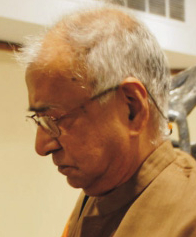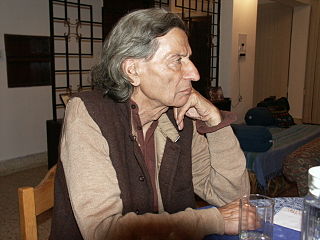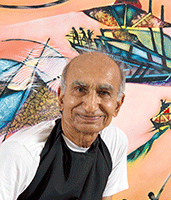Related Research Articles

Ratan Parimoo, born in Kashmir, is an art historian, art educator, pedagogue, artist and former director of the Lalbhai Dalpatbhai Museum, Ahmedabad. Ratan Parimoo was one of the founder members of Baroda Group.

Ghulam Mohammed Sheikh is a painter, poet and art critic from Gujarat, India. He was awarded the Padma Shri in 1983 and Padmabhushan in 2014 for his contribution in field of art.

The Lalit Kala Akademi or National Academy of Art (LKA) is India's national academy of fine arts. It is an autonomous organisation, established in New Delhi in 1954 by Government of India to promote and propagate understanding of Indian art, in and outside the country.
Prayag Jha Chillar, also known as Prayag Jha, is a contemporary Indian artist, who specialized in etching. Her works are kept in collections all over India, including the National Gallery of Modern Art in the capital, Delhi. Jha's work was showcased in solo exhibitions from 1971 to 2012 across Jehangir Art Gallery, Taj Art Gallery, Bajaj Art Gallery, and Art Heritage New Delhi. Her work depicts scenes from the ancient Indian epic Meghdoot and is inspired by natural forms, such as grass and leaves. Jha's earlier works were primarily monochrome, but have evolved to include strong colors.
Sankho Chaudhuri was an Indian sculptor, and a noted figure in the art scene of India. (Although named Naranarain in due family tradition, he was more widely known by his pet name Sankho). Ram Kinker Baij was his teacher. He began close to cubism and then was influenced by István Beöthy, whom he had met in Paris. His themes have included the female figure and wildlife. He has worked in a wide range of media and produced large-scale reliefs and mobiles.

Kalpathi Ganpathi "K.G." Subramanyan was an Indian artist. He was awarded the Padma Vibhushan in 2012.

Keshav Malik was an Indian poet, art and literary critic, arts scholar, and curator. He remained art critic for the Hindustan Times (1960–1972) and The Times of India (1975–2000). He published eighteen volumes of poetry and edited six anthologies of English translations of Indian poetry.
Bhabesh Chandra Sanyal commonly known as B. C. Sanyal, the doyen of modernism in Indian art, was an Indian painter and sculptor and an art teacher to three generations of artists. During his lifetime he not just saw the partition of the Indian subcontinent three times, 1905, 1947 and 1971, but also witnessed 20th century Indian art in all its phases. His notable paintings include The flying scarecrow, Cow herd, Despair and Way to peace, which depicts Mahatma Gandhi with a Hindu and a Muslim child.

V. Anamika is a Contemporary Artist born in Neelankarai, Chennai, Tamil Nadu, a student of S. Dhanapal, an eminent artist of India. She received her master's degree in Fine Arts in 1999 from Government College of Fine Arts, Chennai. She undertook a course on Care of museum objects at Government Museum in 2005. In 2006, she went to Scotland as a visiting artist scholar to learn Japanese wood-block printing at Edinburgh printmaker's studio.

Amar Nath Sehgal was a noted Indian modernist sculptor, painter, poet and art educator. He started his career as an engineer in Lahore, and later turned to art. He shifted to Delhi after partition of India in 1947, and in 1950 studied art education from New York University School of Education. Subsequently, became an art educator, teaching at College of Art, Delhi, and in time a noted modern sculptor to his generation. Though he also ventured into painting, drawings and poetry.

Biman Bihari Das is an Indian sculptor and former Principal of the Government College of Art & Craft, Kolkata. He was honoured by the Government of India, in 2014, by bestowing on him the Padma Shri, the fourth highest civilian award, for his services to the field of Fine Arts.
Rajendra Tiku, is an Indian sculptor and art teacher known for his outdoor stone sculptures. He was honoured by the Government of India, in 2013, by bestowing on him the Padma Shri, the fourth highest civilian award, for his contributions to the field of art.
Dhanraj Bhagat (1917–1988) was an Indian sculptor, considered by many as one of the major sculptors of the Indian subcontinent. He was born in 1917 in Lahore, in the erstwhile British India and secured a diploma in sculpture from the National College of Arts, Lahore. His career started as a member of the faculty at the College of Art, Delhi in 1947 where he rose to the position of the head of the Sculpture Department by the time of his retirement in 1977.
Manu Parekh is an Indian painter, known for his several paintings on the city of Varanasi. Reported to be influenced by Rabindranath Tagore and Ram Kinker Baij, Parekh is a recipient of the 1982 Lalit Kala Akademi Award. The Government of India awarded him the fourth highest civilian award of the Padma Shri, in 1991.
Ranbir Singh Bisht (1928–1998) was an Indian painter and the Principal of the College of Fine Arts, Lucknow University. Born in 1928 at Landsdowne in Garhwal, in the present day Indian state of Uttarakhand, he secured Drawing Teacher's Training Certificate and Diploma in Fine Arts from the Government College of Art and Craft, Lucknow. He conducted many solo shows in a number of Indian cities besides a show in New York and participated in group shows in Frankfurt and Tokyo. He was also a participant of the 4th Triennale at New Delhi in 1972.

Diwan Manna is an Indian conceptual artist and photographer. He completed his study in graphic art and printmaking from the Government College of Art, Chandigarh in 1982. He exhibited in India, United Kingdom, Germany, France, Poland, and Italy. From 2014 to 2015 he served as the director of Triennale India, organised by Lalit Kala Akademi, National Academy of Art, Ministry of Culture, Govt of India. He served as the chairman of Chandigarh Lalit Kala Akademi, State Academy of Art, Department of Culture, Chandigarh Administration. Currently, he is serving as the president of Punjab Lalit Kala Akademi, State Academy of Art, Ministry of Culture, Government of Punjab, India.

Manjot Kaur is a contemporary Indian artist, who lives and works in Chandigarh. She is currently a Visiting Artist Fellow at The Lakshmi Mittal and Family South Asia Institute, Harvard University, Cambridge, Massachusetts, USA.
The GROUP 1890 exhibition was held from 20 to 29 October 1963 at Lalit Kala Akademi, Rabindra Bhavan in New Delhi, India. It was the only exhibition of the artist collective 'group 1890', hence the only existing record of the group's exhibition history in the 1960s contemporary art in India. The group was an entirely male association with 12 members which 'stood passionately and romantically for values of modernism that signaled change'. The members were Raghav Kaneria, M. Reddeppa Naidu, Ambadas Khobragade, Rajesh Mehra, Gulam Mohammed Sheikh, Jagdish Swaminathan, Himmat Shah, Jeram Patel, S. G. Nikam, Eric Bowen, Jyoti Bhatt, and Balkrishna Patel. All of which participated in this inaugural exhibition.

Jayant Parikh is an Indian modern contemporary artist, printmaker, and muralist. He is a student of N. S. Bendre, K. G. Subramanyan and Sankho Chaudhuri. He lives and works in Vadodara, India.

Randeep Maddoke is a Punjab-based concept photographer and documentary filmmaker, born and raised in the village Maddoke, Moga (Punjab). Randeep, an activist turned photographer, is known for his focus on the pains of the marginalised sections of society which are constantly subject to a systematic social exclusion.
References
- ↑ "'Functioning of Akademies should be left to professionals': Diwan Manna". The Indian Express. 3 October 2016.
- ↑ "Objectives".
- 1 2 "PUNJAB LALIT KALA AKADEMI | Punjab Lalit Kala Akademi". lalitkalaakademipunjab.com. Retrieved 2019-05-01.
- ↑ "List of grantees".
- 1 2 3 4 5 Sikh Digital Library. The Spokesman Weekly Vol. 30 No. 18 December 29, 1980.